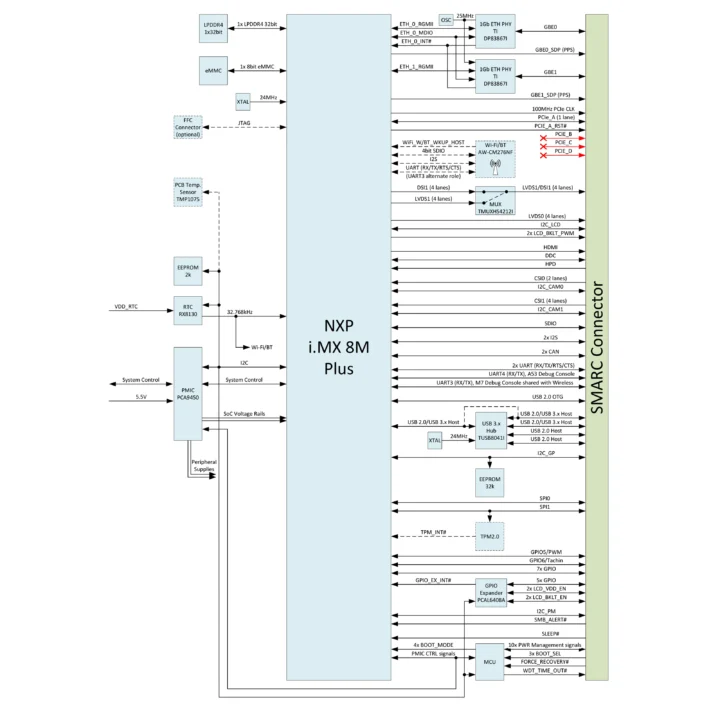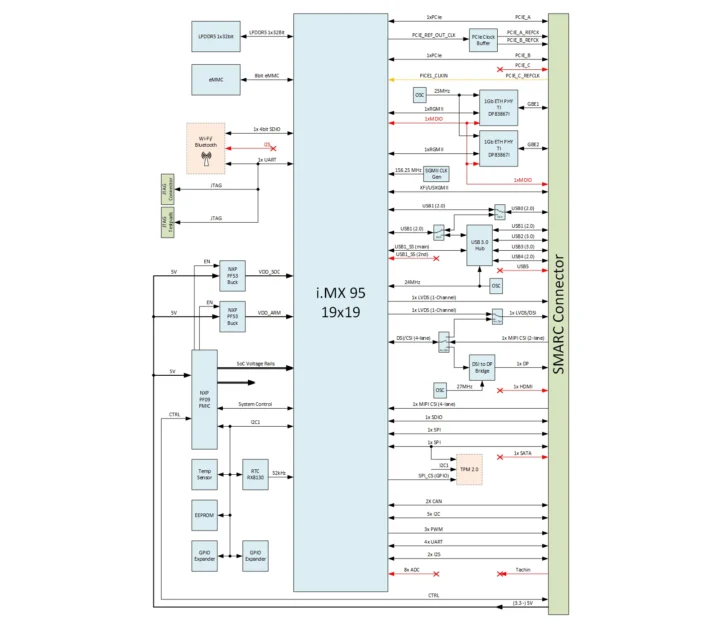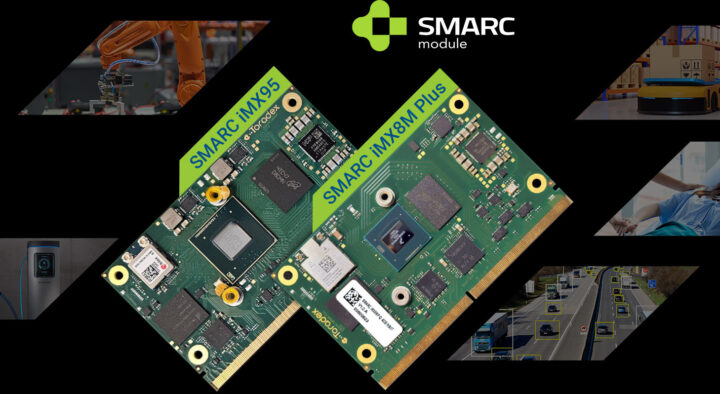Toradex has introduced its first SMARC-compliant system-on-modules (SoMs) with the SMARC iMX8M Plus and SMARC iMX95 SoMs based on NXP i.MX 8M Plus and NXP i.MX 95 SoC respectively.
The company has made proprietary system-on-modules for years with the Colibri, Apalis, Aquila, and Verdin families. Those typically are cost-optimized and use most or all I/Os from the selected SoC, but customers are tied to one supplier: Toradex. To offer more flexibility, the company decided to introduce its first standardized system-on-modules by selecting the SMARC 2.2 standard for compatibility with existing SMARC-compliant carrier boards and adding the Swiss company as an alternative supplier.
Highlights of the SMARC iMX8M Plus module:
- SoC – NXP i.MX 8M Plus
- CPU
- Quad-core ARM Cortex-A53 application processor @ 1.6 GHz
- Arm Cortex-M7 real-time core @ 800 MHz
- GPU – Vivante GC380 2D GPU and GC7000UL 3D GPU
- VPU – 1080p60 video decoder & encoder
- AI accelerator – Optional 2.3 TOPS Neural Processing Unit (NPU)
- CPU
- System Memory – Up to 4GB LPDDR4
- Storage – 32GB eMMC 5.1 flash
- Networking
- 2x TI DP83867I Gigabit Ethernet PHYs
- Dual Band 2.4/5 GHz 2×2 Wi-Fi 5 (802.11ac) + Bluetooth 5.3 via AzureWare AW-CM276NF module
- 314-pin MXM 3.0 edge connector exposing I/Os defined by the SMARC 2.2 standard (excluding some PCIe lanes not supported by the SoC)
- Dimensions – 82 x 50 mm
- Temperature Range – -40° to +85°C
- Availability – At least until 2036

Key features of the SMARC iMX95 module:
- SoC – NXP i.MX 9596
- CPU
- Up to 6x Arm Cortex-A55 application cores clocked at 1.8 GHz (industrial) with 32K I-cache and D-cache, 64KB L2 cache, and 512KB L3 cache
- 1x Arm Cortex-M7 real-time core clocked at 800 MHz
- 1x Arm Cortex-M33 safety core clocked at 333 MHz
- GPU – Arm Mali-G310 V2 GPU for 2D/3D acceleration with support for OpenGL ES 3.2, Vulkan 1.2, OpenCL 3.0
- VPU
- 4Kp30 H.265 and H.264 encode and decode
- JPEG Encoder, JPEG Decoder
- AI Accelerator – NXP eIQ Neutron 2 TOPS neural processing unit (NPU) with 750 inf/sec
- CPU
- System Memory – Up to 16GB LPDDR5
- Storage – Up to 128GB eMMC flash
- Networking
- 2x TI DP83867I Gigabit Ethernet PHYs
- Dual Band 2.4/5 GHz 1×1 Wi-Fi 6 (802.11ax) + Bluetooth 5.2 via unnamed module
- 314-pin MXM edge connector exposing I/Os defined by the SMARC 2.2 standard minus signals not exposed (PCIE_C, USB5, HDMI, SATA, etc…)
- Dimensions – 82 x 50 mm
- Temperature Range – -40° to +85°C
- Availability – At least until 2039

The company mentions support for Torizon Linux, Yocto Project, and Android for the Cortex-A cores, and FreeRTOS, QNX, and Zephyr for the Cortex-M real-time cores. Software for the NXP i.MX 8M Plus is ready, but the NXP i.MX 95 will need more time as samples are only expected in Q2 2025 and mass production in Q4 2025. The NXP i.MX 95 was first announced in January 2023, and 2 to 3 years from announcement to mass production is typical for this type of industrial SoC although we were told sampling would start in H2 2023 to “lead customers” at the time… It does not look like Toradex is offering a SMARC carrier board for evaluation, so you’d have to use your own.

The advantage of getting a standardized system-on-module is that you can shop around and select the vendor with the best price and/or support, or use more than one supplier to make your supply chain more reliable. For instance, there are many other SMARC modules based on NXP i.MX 8M Plus SoC including AAEON uCOM-IMX8P, congatec conga-SMX8M-plus, ADLINK LEC-IMX8MP, and iW-RainboW-G40M among others.
In theory, you can switch one module for the other, but there are always some small differences, for example, memory, storage, and networking chips/modules used may require some software changes, and some small modifications may also be required on the carrier board. That’s probably why Toradex offers a free compatibility check to estimate the effort required for transitioning a SMARC design to use Toradex SMARC modules. Typically, it would take two weeks for the same SoC, four weeks for another Arm SoC, and eight weeks for an x86 SoC.
More details can be found on the products page on the Toradex website. The company also explains why it started offering SMARC modules besides its proprietary modules in the video below.

Jean-Luc started CNX Software in 2010 as a part-time endeavor, before quitting his job as a software engineering manager, and starting to write daily news, and reviews full time later in 2011.
Support CNX Software! Donate via cryptocurrencies, become a Patron on Patreon, or purchase goods on Amazon or Aliexpress






